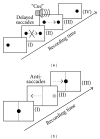Alterations of eye movement control in neurodegenerative movement disorders
- PMID: 24955249
- PMCID: PMC4052189
- DOI: 10.1155/2014/658243
Alterations of eye movement control in neurodegenerative movement disorders
Abstract
The evolution of the fovea centralis, the most central part of the retina and the area of the highest visual accuracy, requires humans to shift their gaze rapidly (saccades) to bring some object of interest within the visual field onto the fovea. In addition, humans are equipped with the ability to rotate the eye ball continuously in a highly predicting manner (smooth pursuit) to hold a moving target steadily upon the retina. The functional deficits in neurodegenerative movement disorders (e.g., Parkinsonian syndromes) involve the basal ganglia that are critical in all aspects of movement control. Moreover, neocortical structures, the cerebellum, and the midbrain may become affected by the pathological process. A broad spectrum of eye movement alterations may result, comprising smooth pursuit disturbance (e.g., interrupting saccades), saccadic dysfunction (e.g., hypometric saccades), and abnormal attempted fixation (e.g., pathological nystagmus and square wave jerks). On clinical grounds, videooculography is a sensitive noninvasive in vivo technique to classify oculomotion function alterations. Eye movements are a valuable window into the integrity of central nervous system structures and their changes in defined neurodegenerative conditions, that is, the oculomotor nuclei in the brainstem together with their directly activating supranuclear centers and the basal ganglia as well as cortical areas of higher cognitive control of attention.
Figures




References
-
- Goldberg ME, Walker MF. The control of gaze. In: Hudspeth AJ, Schwartz JH, Jessell TM, Siegelbaum SA, Kandel ER, editors. Principles of Neural Science. 5th edition. New York, NY, USA: McGraw-Hill; 2013. pp. 894–916.
-
- Leigh RJ, Zee DS. The Neurology of Eye Movements. 4th edition. New York, NY, USA: Oxford University Press; 2006.
-
- Anderson TJ, MacAskill MR. Eye movements in patients with neurodegenerative disorders. Nature Reviews Neurology. 2013;9(2):74–85. - PubMed
-
- MacAskill MR, Graham CF, Pitcher TL, et al. The influence of motor and cognitive impairment upon visually-guided saccades in Parkinson’s disease. Neuropsychologia. 2012;50(14):3338–3347. - PubMed
-
- Pinkhardt EH, Kassubek J. Ocular motor abnormalities in Parkinsonian syndromes. Parkinsonism & Related Disorders. 2011;17(4):223–230. - PubMed
Publication types
LinkOut - more resources
Full Text Sources
Other Literature Sources
Medical

